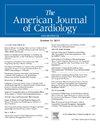Prediction Model of in Hospital Death for Stanford Type A Aortic Dissection Based on a Meta-Analysis of 24 Cohorts
IF 2.3
3区 医学
Q2 CARDIAC & CARDIOVASCULAR SYSTEMS
引用次数: 0
Abstract
Patients with Stanford type A aortic dissection (TAAD) have high postoperative mortality. This study aimed to develop a prediction model for in-hospital death after surgery in patients with TAAD. The derivation cohort came from a meta-analysis. Major risk factors were counted. The corresponding hazard ratio was reported to establish a prediction model for in-hospital death in patients with TAAD. Validation cohorts from 2 centres were used to evaluate the prediction model. The meta-analysis included 24 cohort studies with a total of 11,404 patients and 1,554 patients died early after surgery. Risk factors for the prediction model included age, body mass index, smoking, coronary heart disease, preoperative stroke, shock, preoperative cardiopulmonary resuscitation, pericardial tamponade and malperfusion. Patients with TAAD admitted to the First and the Fourth Hospital of Hebei Medical University between January 2020 and June 2024 were retrospectively collected. Patients from the 2 hospitals constituted validation cohorts A (n = 262) and B (n = 138). Risk scores were calculated for model validation and the prediction model demonstrated better differentiation for validation cohort A, with an area under the curve of 0.886 (95% confidence interval 0.842 to 0.931). This study established a simple risk prediction model, including 13 risk factors, to predict in-hospital death in patients with TAAD. However, multicenter data is still needed to evaluate the prediction accuracy of the model.
基于24个队列meta分析的Stanford A型主动脉夹层住院死亡预测模型
目的:Stanford A型主动脉夹层(TAAD)患者术后死亡率高。本研究旨在建立TAAD患者术后院内死亡的预测模型。方法:衍生队列来自荟萃分析。统计主要危险因素。报告相应的风险比,建立TAAD患者院内死亡预测模型。使用来自两个中心的验证队列来评估预测模型。结果:meta分析纳入24项队列研究,共11404例患者,1554例患者术后早期死亡。预测模型的危险因素包括年龄、体重指数、吸烟、冠心病、术前脑卒中、休克、术前心肺复苏、心包填塞和灌注不良。回顾性收集2020年1月至2024年6月在河北医科大学第一医院和第四医院住院的TAAD患者。两家医院的患者组成验证队列A (n = 262)和B (n = 138)。计算风险评分进行模型验证,验证队列A预测模型具有较好的分化性,曲线下面积为0.886(95%可信区间0.842 ~ 0.931)。结论:本研究建立了一个包含13个危险因素的简单的TAAD患者院内死亡预测模型。然而,仍然需要多中心数据来评估模型的预测精度。
本文章由计算机程序翻译,如有差异,请以英文原文为准。
求助全文
约1分钟内获得全文
求助全文
来源期刊

American Journal of Cardiology
医学-心血管系统
CiteScore
4.00
自引率
3.60%
发文量
698
审稿时长
33 days
期刊介绍:
Published 24 times a year, The American Journal of Cardiology® is an independent journal designed for cardiovascular disease specialists and internists with a subspecialty in cardiology throughout the world. AJC is an independent, scientific, peer-reviewed journal of original articles that focus on the practical, clinical approach to the diagnosis and treatment of cardiovascular disease. AJC has one of the fastest acceptance to publication times in Cardiology. Features report on systemic hypertension, methodology, drugs, pacing, arrhythmia, preventive cardiology, congestive heart failure, valvular heart disease, congenital heart disease, and cardiomyopathy. Also included are editorials, readers'' comments, and symposia.
 求助内容:
求助内容: 应助结果提醒方式:
应助结果提醒方式:


